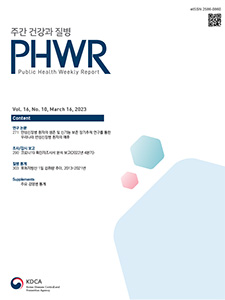Current Issue
Vol.16 No.10, March 16, 2023
-
Original Articles 2023-03-16
 1
1
 3270
3270
 412
412
Long-Term Prognosis of Chronic Kidney Disease Patients in the Republic of Korea: From the KNOW-CKD Study
Eunjeong Kang, Kook-Hwan Oh
Public Health Weekly Report 2023; 16(10): 271-289 https://doi.org/10.56786/PHWR.2023.16.10.1 Abstract
AbstractThe aim of this study was to investigate the incidences of renal events, all-cause deaths, and cardiovascular events from Korean chronic kidney disease (CKD) patients. This study was conducted using the data obtained from the ‘KoreaN cohort study for Outcome in patients With CKD (KNOW-CKD),’ a long-term prospective cohort study of CKD in the Republic of Korea (ROK). From January 2011 to June 2016, adult non-dialyzed CKD patients aged 20–75 were enrolled at nine hospitals in the ROK. During follow-up until March 31, 2022, the glomerular filtration rate declined at a rate of 2.62±0.07 ml/min/1.73 m2/year on the average. During the follow-up, 183 deaths (11.7 per 1,000 person-years), 221 cardiovascular events (15.2 per 1,000 person-years), and 689 dialysis or transplantation events (53.1 per 1,000 person-years) occurred. All-cause mortality and incidence of cardiovascular disease (CVD) were the highest in the diabetic nephropathy group, and tended to increase at higher CKD stages. Compared to the general population, CKD patients exhibited higher risk of adverse outcomes; the hazard ratio (HR) for all-cause mortality was 2.25 (95% confidence interval [CI] 1.95–2.60), and the HR for cardiovascular events was 1.42 (95% CI 1.00–2.02). All-cause mortality risk In CKD patients in all CKD stages significantly increased compared to that in the general population. In a meta-analysis and international comparison study, Korean CKD patients exhibited relatively higher risk of renal events, while they demonstrated relatively lower all-cause mortality and CVD risk. These results provide an important implication in establishing national policies and treatment plan for Korean CKD patients.
-
Surveillance Reports 2023-03-16
 1
1
 7905
7905
 250
250
Analysis Report on COVID-19 Case Reporting Form Data (Fourth Quarter of 2022)
Eun Sol Lee, Mi Jeong Ko, Young-Man Kim, So Yeon Park, Do Sang Lim, Young-Joon Park, Donghyok Kwon
Public Health Weekly Report 2023; 16(10): 290-302 https://doi.org/10.56786/PHWR.2023.16.10.2 Abstract
AbstractThe Korea Disease Control and Prevention Agency has been conducting a complete investigation of coronavirus disease 2019 (COVID-19) confirmed patients and their contacts. In January 2022, the number of confirmed cases increased rapidly due to the development of dominant Omicron variants, which demanded a new quarantine response strategy. On February 7, 2022, a self-report COVID-19 case reporting form was introduced, allowing confirmed patients to enter their basic epidemiological information in the questionnaire. In the fourth quarter of 2022, the registration status of the COVID-19 case reporting form was 98.9%. The registration rate using the self-report COVID-19 case reporting form continued to rise monthly. In the status of each major item, no differences were found in terms of presence of symptoms, underlying diseases, time taken for the diagnosis of confirmed diseases, and the ratio of members of facilities vulnerable to infection. With respect to the status of cohabitants, no significant change in the number of cohabitants per index patient was observed; however, the secondary incidence rate tended to decrease by a small degree every month. There may be limitations in generalizing the monitoring results because input values are not verified for COVID-19 case reporting form data. Therefore, it is necessary to verify the accuracy of the data registered in COVID-19 case reporting form by comparing each item with other objectified data sources. It will be used as evidence for policy preparation through additional analysis of each item of the COVID-19 case reporting form.
-
QuickStats 2023-03-16
 0
0
 452
452
 122
122
Trends in the Intake of Saturated Fatty Acids, During 2013–2021
Public Health Weekly Report 2023; 16(10): 303-304 https://doi.org/10.56786/PHWR.2023.16.10.3

pp. 1433~1461
Most Keyword
?
What is Most Keyword?
- It is the most frequently used keyword in articles in this journal for the past two years.
Most Read
-
Waterborne and Foodborne Disease Outbreaks in the Republic of Korea, 2023
Myung-Jae Hwang, So Yeon Park, Hyungjun Kim, Se Jeong Yang, Sungchan Yang, Jin Seon Yang
Public Health Weekly Report 2025;18: 17-32 https://doi.org/10.56786/PHWR.2025.18.1.2 -
Implementation Plan for the Coronavirus Disease 2019 Vaccination for the 2024–2025 Season: Recommendations of the 6th Expert Committee on Immunization Practices
Hyewook Hwang, Wookeon Lee, Seohyeon Ahn, Young-Sook Choi, Seunghyun Lewis Kwon, Dongwoo Lee, Eun Hwa Choi, SokGoo Lee
Public Health Weekly Report 2025;18: 90-102 https://doi.org/10.56786/PHWR.2025.18.2.3
Editorial Office
+82-43-719-7569





 Full Text
Full Text Cite
Cite


